
U.S. Space Shuttle (Space Transport System)
technical - facilities


U.S. Space Shuttle (Space Transport System)
technical - facilities

A number of facilities were designed to be carried in the space shuttle's payload bay, returned to Earth, refurbished and re-used on other missions.
These included pressurised habitable and non-habitable modules as well as un-pressurised carriers. They were either fixed or removable during the mission.
Three main types of re-usable facilities were flown in the shuttle's payload bay:-
▽ Spacelab : Pressurised research modules and un-pressurised pallets.
▽ SPACEHAB : Pressurised research and logistics modules and un-pressurised pallets.
▽ Multi-Purpose Logistics Modules : Pressurised logistics modules temporarily docked to station.
Spacelab is a re-usable, research laboratory facility carried in the payload bay of the shuttle. It consists of two major elements: a pressurized, habitable laboratory called a module and unpressurized platforms called pallets designed to support instruments which require direct exposure to space.
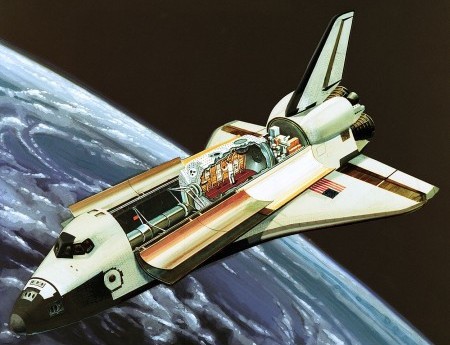
The Spacelab Module comprises a cylindrical main laboratory flown in the rear of the Space Shuttle cargo bay, connected to the crew compartment by a tunnel. The module comes in two sections, a core segment and an experiment segment.
The core segment can be flown by itself, in what is called the short module configuration, or coupled in tandem with the experiment segment in the long module configuration.
Most of the time two segments were used in forming the Long Module configuration.
Module Core Segment - houses data processing equipment and utilities for the module and pallets when both are flown together.
Module Experiment Segment - provides further pressurized work area, space for additional experiment racks, and provision for mounting a scientific airlock to expose experiments carried in the module to the space environment.
The laboratory had an outer diameter of 4.12 meters (13.5 ft), and each segment a length of 2.7 meters (8.9 ft). Two habitable modules were built, named LM1 and LM2.
The Spacelab Pallet is a U-shaped platform for mounting instrumentation, large instruments, experiments requiring exposure to space, and instruments requiring a large field of view, such as telescopes. It has several hard points for mounting heavy equipment.
It can be used in single configuration or stacked end to end in double or triple configurations. Up to five pallets can be configured in the Space Shuttle payload bay by using a double pallet plus a triple pallet.
When pallets are flown without the module, the subsystems necessary for experiment operation are contained in a pressurized cylinder called an "igloo".
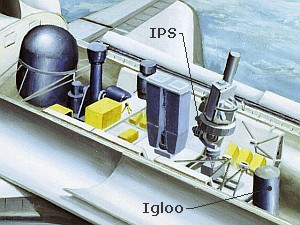
On space flights where pallets were flown without a habitable module, a pressurized cylinder known as the igloo was included.
The igloo was used to house and protect the subsystems needed to operate the Spacelab pallet equipment.
It was 10 feet tall, had a diameter of 5 feet, and weighed 2,500 lb.
Two igloo units were manufactured, both by Belgium company SABCA, and both were used on space flights in the shuttle.
The Instrument Pointing System (IPS) was a gimbaled pointing device, capable of aiming telescopes, cameras, or other instruments. It was manufactured by Dornier.
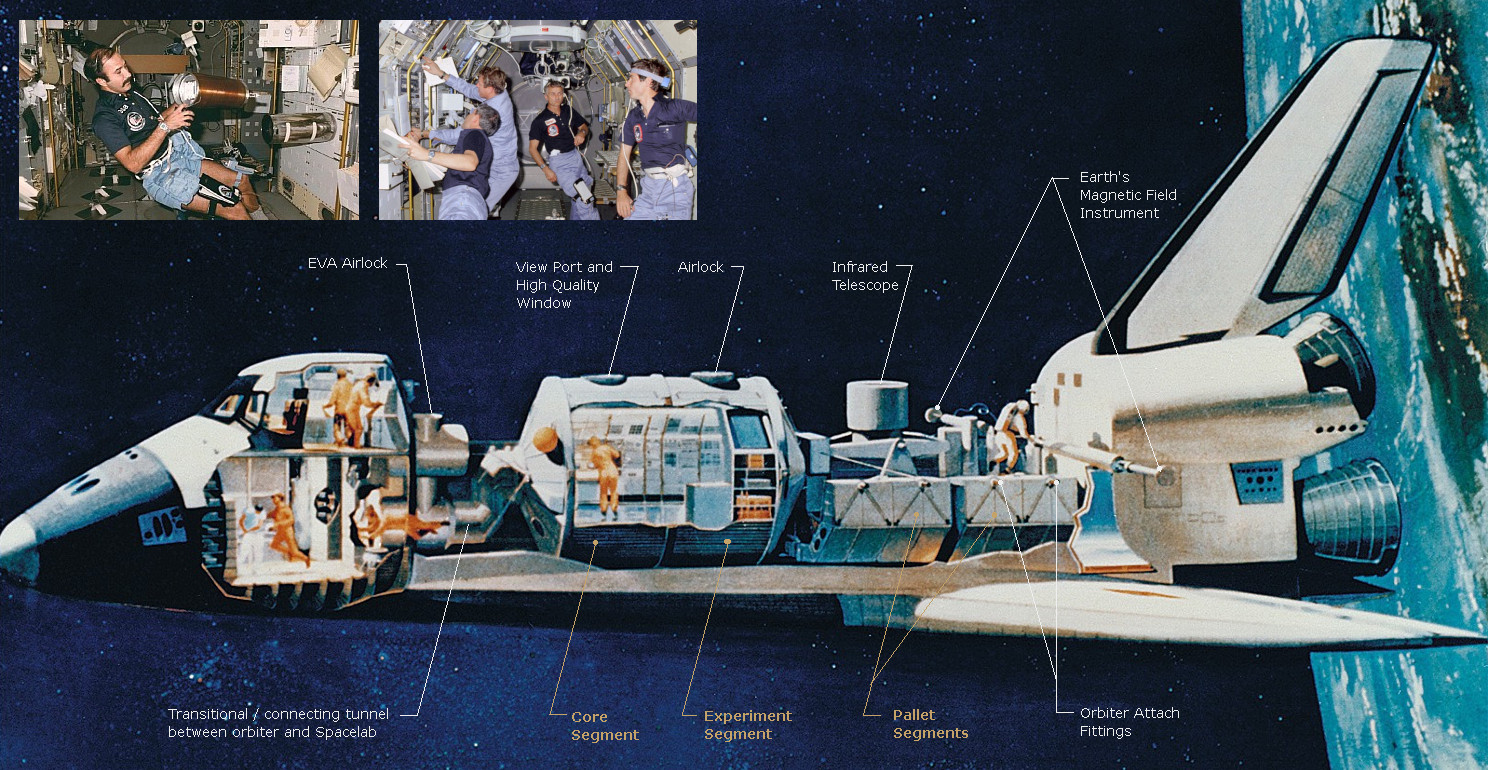
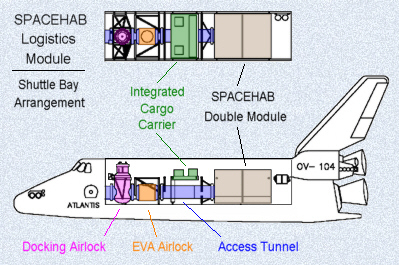
U.S. commercial company SPACEHAB Inc. has been called Astrotech Corporation since 2009. It provided space habitat microgravity experimentation equipment and services to NASA during the Space Shuttle era.
Initially used for microgravity research, it was then used for supporting the docking program between the shuttle and the Russian space station, Mir.
Finally it was used as a key facility to support the building and operation of the International Space Station (ISS).
SPACEHAB hardware includes:-
Pressurised Modules: Single Module (SM), Logistics Single Module (LSM) and Logistics Double Module (LDM).
Integrated Cargo Carrier (ICC) An un-pressurized flatbed pallet.
External Stowage Platforms (ESP-2 and ESP-3) based on the ICC and permanently mounted on the International Space Station.
This hardware was specifically designed to fit inside the payload bay of the shuttle and remain there during the mission.
The Pressurized module is habitable and located in the forward end of the shuttle orbiter cargo bay. It is accessed from the orbiter mid deck through a tunnel adapter connected to the airlock. An additional airlock is attached to this tunnel so that space walks (EVA's) can be performed while the shuttle is docked to the ISS.
Two SPACEHAB modules can be joined together to form a "Double Module" which were used on most of the Mir and ISS missions. Equipment can also be carried externally on the roof of the Spacehab double module and accessed during Space-walks (EVA's).
A SPACEHAB Research Double Module (RDM) flew only on the ill-fated Columbia STS-107 mission, in which it was destroyed.
Capacity: up to 4,536 Kg (10,000 lbs)
Length: 6.1 m (20 ft)
Width: 4.3 m (14 ft)
Height: 3.4 m (11.2 ft)
Material: Aluminum
* Pressurised with ventilation and lighting
* Ability to accommodate powered payloads
* External rooftop stowage locations - 4
* Double rack locations - 4 (2 powered)
* Bulkhead mounted mid-deck lockers - 61
* Floor storage for large unique items
* Soft stowage
* Food
* Water
* Clothing
* Sleeping bags
* Personal hygiene articles
* Health care supplies
* Medical support equipment
* Exercise equipment
* Maintenance spares
* Computer Equipment
* TV and movie equipment
* Fire detection and suppression
* Office supplies
* Environmental supplies
* Vacuum cleaner
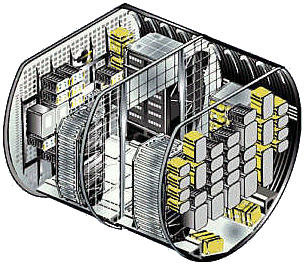
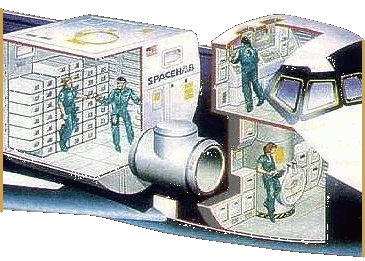
An un-pressurized flatbed pallet housed in the shuttle's payload bay for the duration of the mission. It was only used on shuttle missions to the International Space Station.
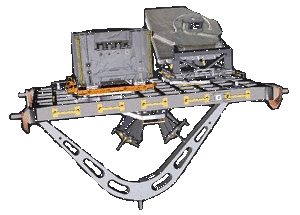
ICC is a two-part structure consisting of a waffle-like aluminum box-beam pallet and keel-yoke assembly and is capable of carrying cargo on both faces of the pallet, atop and below. It carries cargo which does not require pressurisation and would otherwise have to be carried in the shuttle's cabin.
There are no active interfaces (thermal, electrical or data) to the shuttle. The ICC cargo is removed during space-walks for external installation or storage on the Station.
Russian contractor RSC-Energia made the Un-pressurized Cargo Pallet (UCP).
Astrium GmbH made the Keel Yoke Assembly (KYA) and provided mission integration and operations support. The KYA anchors the UCP in the Shuttle cargo bay.
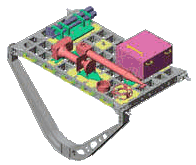
* OTD - ORU Transfer Device
* STRELA Cargo Crane - Mounted on the exterior of the Russian segment.
* SHOSS - SPACEHAB-Oceaneering Space System box
* SOAR - Space Integrated Global Positioning System / Inertial Navigation System Orbital Attitude Readiness payload.
* LCA - Lab Cradle Assembly with the Module Truss Structure Attach System installed.
* PFCS - Pump Flow Control Subassembly with attached Flight Support Equipment.
* ESP - External Stowage Platform
* Rigid Umbilical - Wiring for power, data and video between Destiny and Canadarm2
* EATCS - External Active Thermal Control System pump module
* TUS-RA, IUA - Trailing Umbilical System Reel Assembly, Interface Umbilical Assembly.
* SMDP - Service Module Debris Panels
* STP-H2 - Space Test Program H2 which deploys three satellites.
* AMPs - Adjustable Mass Plates.
* PFRAM - ISS Passive Flight Releasable Attachment Mechanism
Capacity: up to 2,721 kg (6,000 lbs)
Length: 2.4 m (8 ft)
Width: 4.6 m (15 ft)
Thickness: 25 cm (10 inches)
Material: Aluminum ▲
The Multi-Purpose Logistics Module (MPLM) is a pressurised cargo module built for NASA by the Italian Space Agency, Agenzia Spaziale Italiana (ASI), at the Alenia Aerospazio factory in Turin, Italy. This is main Italian contribution to the International Space Station. Italy is one of the partner nations in the ISS project.
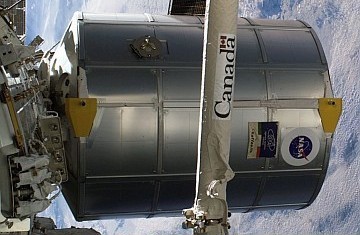
The MPLM carries equipment, supplies, laboratory racks and experiments for the station and is transported to the ISS in the shuttle's payload bay. There is no internal access from the shuttle to the module.
After the shuttle is docked to the Station the MPLM is lifted from the cargo bay using the shuttle's or the station's robot arm. It is then connected to a station berthing port using the Common Berthing Mechanism (CBM), which locks it in place with an airtight seal.
The MPLM is then be unloaded directly into the station and re-loaded with waste and items to be returned to Earth. At the end of the mission the MPLM is undocked from the station and re-berthed in the shuttle's payload bay for return to Earth. The MPLM is then re-conditioned for its next mission.
Three Multi-Purpose Logistics Modules have been built to allow time for turn around and back-up. The modules have been named after famous Italians of the past:
Leonardo: Named after Leonardo da Vinci, an extraordinary Italian inventor-scientist, civil engineer, architect and artist.
Raffaello: Named after Raffaello Sanzio, an artist renowned for his visual achievement of human grandeur.
Donnatello: Named after Donato di Niccolo DI Betto Bardi, one of the greatest sculptors of all time. (Was not flown)
The following specifications apply to all three MPLMs:
Length: 6.4 meters (21 feet)
Diameter: 4.6 meters (15 feet)
Weight: 4.1 metric tons
Capacity: 9.1 metric tons of cargo
Shape: Cylinder
Material: Aluminum
The following Systems are included in all three MPLMs:
* Life support
* Fire detection and suppression
* Electrical distribution
* Computer
* Equipment racks: 16 (5 powered)
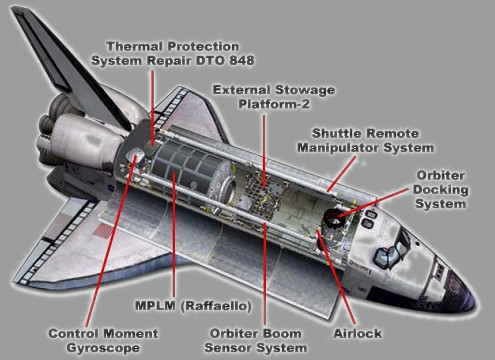
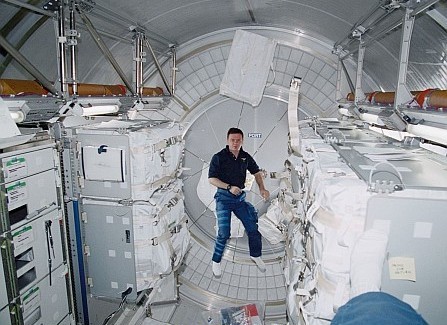
Typical MPLM cargo:
* U.S. Laboratory System Racks
* Re-supply Stowage Platforms
* Re-supply Stowage Racks
* Human Research Facility racks
* Science experiment racks
* EXPRESS Racks (EXpedite the PRocessing of Experiments to the Space Station).
Typical contents of racks and platforms:
* Crew rotation hardware
* Avionics hardware
* Crew Health Care System items
* The ISS ergometer
* Robotic Workstation equipment
* HRF experiment equipment
* Food and supplies to support the crew
* Spare parts for systems on the Station
* Space walking gear